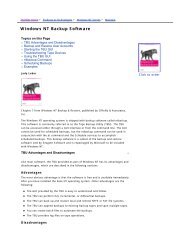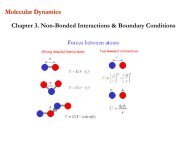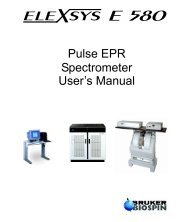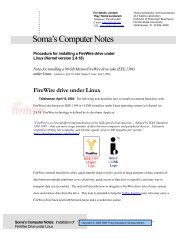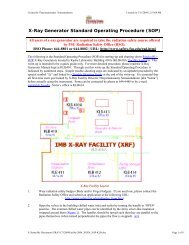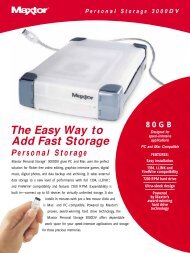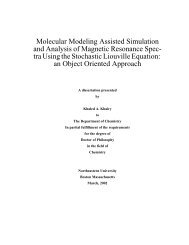HC SERIES - Taylor-Wharton
HC SERIES - Taylor-Wharton
HC SERIES - Taylor-Wharton
You also want an ePaper? Increase the reach of your titles
YUMPU automatically turns print PDFs into web optimized ePapers that Google loves.
TW-27<br />
<strong>HC</strong> <strong>SERIES</strong><br />
High Capacity<br />
Liquid Nitrogen<br />
Refrigerators<br />
The High Capacity Series of Cryogenic Refrigerators is<br />
designed for storing large quantities of material at liquid<br />
nitrogen temperature. Seven different models provide<br />
holding times and capacities to fit a variety of storage<br />
needs. Applications range from industrial to laboratory;<br />
biological and non-biological material. Low-profile (<strong>HC</strong>L)<br />
models are available for applications where a shorter unit<br />
may be needed.<br />
Material to be stored in cryogenic refrigerators is placed in<br />
canisters which are suspended from the top of the unit<br />
and immersed in liquid nitrogen and cold nitrogen vapor.<br />
When immersed in liquid nitrogen, storage temperatures<br />
are -320°F (-196°C). Vapor-phase temperatures above<br />
the liquid will vary according to the physical characteristics<br />
of the refrigerator. In <strong>HC</strong> Series units, this temperature<br />
generally will vary between -300°F (-184°C) under<br />
the closed necktube core and -320°F (-196°C) at the<br />
surface of the liquid.<br />
§ Optimal Holding Time – Modern materials and insulation<br />
system design are combined to provide a line of<br />
refrigerators with optimal holding times consistent with<br />
high volume storage.<br />
§ Rugged, Dependable – Construction details such as an<br />
aluminum ribbed body, a tough paint system and rugged<br />
necktube design provide exceptional durability for a<br />
vacuum insulated container.<br />
§ Ease of Operation - Canisters can be inserted or<br />
removed easily due to generous inner vessel headroom<br />
and a convenient canister indexing system that includes<br />
a guiding fixture inside the unit. The lightweight, thermally<br />
efficient design provides optimal portability for<br />
every container.<br />
§ High Capacity - The exceptional capacities of these<br />
units are derived from a design that accommodates<br />
large canister sizes and a greater number of canisters.
Safety<br />
Before using any Cryogenic Refrigerator, read the Handle<br />
with Care booklet provided with the unit. It details safety<br />
and unit care precautions that must be read an understood<br />
before using the equipment. If a replacement<br />
booklet is needed, order publication TW-10 from your<br />
supplier.<br />
Following are a few of the precautions described in the<br />
Handle with Care booklet. Please be sure to read the<br />
entire booklet before using these refrigerators.<br />
Use only liquid nitrogen or liquid argon in these refrigerators.<br />
The use of liquid air or liquid nitrogen may cause an<br />
explosion or fire. Do not touch liquid or cold metal surfaces<br />
with your bare skin. The liquid nitrogen stored in<br />
these containers is extremely cold: -320°F (-196°C).<br />
Exposure to skin or eyes to liquid, cold gas, or frosted parts<br />
could result in a severe frost-bite like injury.<br />
Because of the extremely low temperature, a face shield<br />
and gloves must be worn when transferring liquid into or out<br />
of these refrigerators.<br />
Use only the necktube core provided with this unit or a<br />
listed replacement part. A tight-fitting plug or stopper will<br />
cause a pressure increase in the refrigerator that may<br />
damage the container and/or cause personal injury.<br />
Store and use these refrigerators only in well ventilated<br />
places. In a confined area, nitrogen from these units may<br />
cause suffocation by displacing air needed for breathing.<br />
Operation<br />
Filling – Adding liquid nitrogen to a warm container may<br />
cause splashing and will generate a significant volume of<br />
nitrogen gas as cold liquid contacts warm surfaces. Add<br />
liquid slowly to minimize these effects. Be sure there is<br />
adequate ventilation. Keep your head clear of the heavy<br />
volume of vapor that may be produced; it is extremely cold<br />
and could cause personal injury.<br />
Determining Liquid Level – The liquid level in the container<br />
can be determined by measuring with a dipstick. Insert the<br />
dipstick straight into the container so that is always rest on<br />
the bottom of the unit. After 5 or 10 seconds, withdraw the<br />
dipstick and wave it back and forth in the air. A frosted<br />
section will form representing the depth of liquid in the<br />
container.<br />
not being accessed. When accessing stored material, the<br />
necktube core should be removed as briefly as possible.<br />
When inserting or removing canisters, grasp the canister<br />
handle, life and tilt the canister toward the center of the<br />
refrigerator, and withdraw the canister only far enough to<br />
remove the contents. Completely withdrawing the canister<br />
will unnecessarily expose stored materials to warm conditions.<br />
WARNING<br />
Never use hollow rods or tubes as dipsticks. When a<br />
warm tube is inserted into liquid nitrogen, liquid will<br />
spout from the top of the tube and may cause personal<br />
injury.<br />
The liquid level chart shows volume of liquid nitrogen vs.<br />
depth for <strong>HC</strong> Series refrigerators. These values are approximate<br />
and are based on a standard condition with no stored<br />
material in the container; with stored material, the liquid<br />
volume will be slightly less than the value from the chart.<br />
0RGHO /LWHUV,QFK /LWHUV&HQWLPHWHU<br />
+&/+& <br />
+&/+&+&<br />
<br />
<br />
9+&9+&<br />
Inserting or Removing Canisters – To prevent the unnecessary<br />
loss of liquid nitrogen refrigerant, the necktube core<br />
should remain in the container when the stored material is<br />
WARNING<br />
Some canisters have liquid drain openings; some do<br />
not. If canisters are completely removed from the<br />
container, liquid nitrogen may remain in the canister or<br />
drain from the bottom. When removing canisters, stop<br />
briefly at the necktube to allow the liquid to drain<br />
completely, then handle the canister carefully to prevent<br />
personal injury.<br />
When room temperature product is added, slowly lower the
Operation (cont.)<br />
canister into the refrigerator to reduce the boiling of refrigerant<br />
and the surge of cold nitrogen gas. When inserting the<br />
canister, tilt the bottom of the canister in the direction of the<br />
index ring notch. The numbers on the index ring notches are<br />
a convenient aid to inventory control.<br />
by a seal or lock through tabs on the edge of the lid assembly.<br />
When the lid is closed, insert the seal through the<br />
access slot located opposite the hinge.<br />
Securing contents - Refrigerator contents may be secured<br />
Specifications<br />
5HIULJHUDWRU +&/ +& +&/ +& +& 9+& 9+&<br />
2YHUDOO+HLJKWV LQ LQ LQ LQ LQ LQ LQ<br />
PP PP PP PP PP PP PP<br />
2YHUDOO'LDPHWHU LQ LQ LQ LQ LQ LQ LQ<br />
PP PP PP PP PP PP PP<br />
1HFN'LDPHWHU LQ LQ LQ LQ LQ LQ LQ<br />
PP PP PP PP PP PP PP<br />
:HLJKW)XOO OE NE OE OE NE NE OE<br />
NJ NJ NJ NJ NJ NJ NJ<br />
:HLJKW(PSW\ OE OE OE OE OE OE OE<br />
NJ NJ NJ NJ NJ NJ NJ<br />
/LTXLG1LWURJHQ&DSDFLW\ / / / / / / /<br />
1XPEHURI&DQLVWHUV <br />
&DQLVWHU'LDPHWHU LQ LQ LQ LQ LQ LQ LQ<br />
PP PP PP PP PP PP PP<br />
&DQLVWHU+HLJKW LQ LQ LQ LQ LQ LQ LQ<br />
PP PP PP PP PP PP PP<br />
6WDWLF+ROGLQJ7LPHGD\V <br />
:RUNLQJ7LPHGD\V <br />
(YDSRUDWLRQ5DWH/'D\ <br />
9LDO&DSDFLW\ <br />
6WUDZ&DSDFLW\<br />
FFVWUDZV <br />
FFVWUDZV <br />
)RRWQRWHV<br />
<br />
1LQHFDQLVWHUYHUVLRQDYDLODEOHZLWK[LQ[PPFDQLVWHU<br />
<br />
7KHYDOXHVJLYHQDUHQRPLQDO%DVHGRQDFRQWDLQHUZLWKQRFDQLVWHUVWKH\ZLOOYDU\VOLJKWO\ZLWKPDQXIDFWXULQ<br />
WROHUDQFHVDQGDWPRVSKHULFFRQGLWLRQV7KHDJHRIWKHFRQWDLQHUDQGLWVFRQWHQWVZLOODOVRHIIHFWWKLVYDOXH<br />
<br />
:RUNLQJWLPHLQDQDUELWUDU\UHIHUHQFHRQO\YDOXHWRHVWLPDWHFRQWDLQHUSHUIRUPDQFHXQGHUWKHDFWXDO<br />
RSHUDWLRQJFRQGLWLRQV$FWXDOZRUNLQJWLPHPD\YDU\ZLGHO\GHSHQGLQJRQLQGLYLGXDOXVHSDWWHUQV<br />
<br />
FFSODVWLFYLDOVRQFDQHVPPGLDYLDOVSHUFDQH7KHVHFDSDFLWLHVUHIOHFWZRUNLQJFDSDFLWLHV<br />
<br />
PPJREOHWVRQHOHYHO<br />
<br />
PPJREOHWVWZROHYHOV
Refrigeration Construction<br />
A cryogenic refrigerator is really two containers, one within<br />
the other. High-technology is used in a sealed vacuum<br />
space between inner and outer containers. The integrity of<br />
the vacuum is the key to continued performance.<br />
All refrigerators fail eventually. A perfect vacuum system<br />
that does not leak cannot be achieved. Some minute<br />
leakage of air molecules into the vacuum occurs from the<br />
moment of manufacture. A “Vacuum Maintenance System”,<br />
consisting of materials, is built into the vacuum space to<br />
prolong the service life of the container by many years. The<br />
Vacuum Maintenance System can intercept these trace<br />
leaks of air molecules only up to a point. Then the vacuum<br />
will become less efficient and nitrogen will boil off more<br />
rapidly.<br />
The most frequent cause of vacuum failure is abuse. The<br />
inner container is supported by the necktube, which supports<br />
the weight of the liquid contents as well. A blow to the<br />
refrigerator may cause the necktube to deform or break. Any<br />
unit subjected to physical damage may fail more rapidly<br />
than one that has been carefully handled.<br />
Routine Care & Maintenance<br />
Ice accumulation inside the necktube is caused by condensation<br />
of moisture in the air. If ice-build up interferes with<br />
normal operation of the refrigerator, the unit should be<br />
emptied and thawed. To thaw the unit, pour out the liquid,<br />
disposing of it out-of-doors where the cold liquid will not<br />
damage driveways and other surfaces. Warm the refrigerator<br />
by purging it with a stream of room-temperature air.<br />
Continue purging with air even after the refrigerator is<br />
warmed to evaporate any collected moisture. When the<br />
refrigerator is ice-free and dry, rinse the inner vessel with<br />
household bleach. Wash the inner vessel with solution (40<br />
to 1 water to laundry detergent). Rinse and dry inside and<br />
out thoroughly before placing the container back into<br />
service.<br />
DO NOT attempt to fasten any device to the refrigerator.<br />
Welding, brazing, or piercing of the refrigerator in any<br />
manner will cause permanent damage and will void your<br />
warranty.<br />
Check liquid levels regularly. If high evaporation rates are<br />
apparent under normal operating conditions, the refrigerator<br />
may be losing its vacuum. Sweating or freezing of the<br />
outside casing are definite indications that the insulation<br />
integrity is not normal. Read the Handle with Care booklet<br />
(TW-10) for more information on the proper handling of your<br />
cryogenic refrigerator.<br />
Transportation<br />
Although these refrigerators are rugged, they can be<br />
damaged if abused or otherwise mishandled. When moving<br />
or transporting a refrigerator, take every precaution to<br />
prevent sliding, tipping, bumping or dropping the unit.<br />
Refrigerators containing liquid nitrogen must never be<br />
transported in unventilated compartments. Ventilation must<br />
be assured to prevent the displacement of air and the<br />
related suffocation hazard.<br />
Ordering Information – Order all replacement parts and<br />
accessories from your distributor. Please include the part<br />
and model number of your refrigerator, the part number,<br />
quantity, and description of each part requested. For<br />
more information or the name of your local distributor,<br />
contact <strong>Taylor</strong>-<strong>Wharton</strong> at the address listed.<br />
<strong>Taylor</strong>-<strong>Wharton</strong><br />
4075 Hamilton Boulevard<br />
Theodore, AL 36582<br />
Phone (334) 443-8680<br />
Fax: (334) 443-2250<br />
In U.S. and Canada: (800) TW TANKS (898-2657)
Replacement Parts<br />
5HIULJHUDWRUV +&/ +& +&/ +& +& 9+& 9+&<br />
&DQLVWHU6LQJOH 5& 5& 5& 5& 5& 5& 5&<br />
1HFNWXEH&RUH 5& 5& 5& 5& 5& 5& 5&<br />
0RGHO/DEHO7RS 5& 5& 5& 5& 5& 5& 5&<br />
0RGHO/DEHO6LGH 5& 5& 5& 5& 5& 5& 5&<br />
<br />
5HSODFHPHQWSDUWVIRUQLQHFDQLVWHUYHUVLRQ5&&DQLVWHU5&1HFNWXEH&RUH<br />
Common Parts (for all models unless otherwise specified)<br />
Lid R033-9C11 Warranty Label R033-9C42<br />
Lid Hinge Pin (2 required) 6550-1000 Handle (12<strong>HC</strong>L) R010-5C11<br />
Lid Hinge Pin Retainer 8956-1013 Handle Pin (12<strong>HC</strong>L) 6560-1006<br />
Warning Label R033-9C28 Handle Pin Retainer (12<strong>HC</strong>L) 8830-6309<br />
Accessories<br />
The following accessories are available for <strong>HC</strong> Series<br />
Refrigerators:<br />
§ A Roller Base with ball bearing swivel casters to<br />
provide convenience and portability within a working<br />
area where frequent container movement is necessary<br />
and desirable.<br />
P/N R018-8C00…………......for 12<strong>HC</strong>L and 20<strong>HC</strong><br />
P/N R033-8C00……………...for 21<strong>HC</strong>L, 34<strong>HC</strong>, 35<strong>HC</strong><br />
35V<strong>HC</strong>, and 36V<strong>HC</strong><br />
§ A Necktube Freezer Tray for use with 35<strong>HC</strong> and<br />
35V<strong>HC</strong> refrigerators. This device may be used to cool<br />
limited quantities of material at varying controlled<br />
temperatures.<br />
§ A Liquid Level Measuring Rod that is graduated in both<br />
inches and centimeters. This accessory is inserted into<br />
the cryogenic refrigerant to determine the actual liquid<br />
level.<br />
P/N R033-8C11 …………….for all units<br />
§ A Low Liquid Level Alarm for all passive monitoring of<br />
refrigerant level. This battery powered alarm is available<br />
for units that may be used for long term storage, where an<br />
unusual low liquid could go unnoticed.<br />
P/N R034-8C15 …………….for 34<strong>HC</strong><br />
P/N R037-8C15 …………….for 35<strong>HC</strong><br />
P/N R036-8C30 …………….for 35V<strong>HC</strong><br />
P/N R038-8C15 …………….for 36V<strong>HC</strong><br />
P/N R036-9C27 …………….for 35<strong>HC</strong> and 35V<strong>HC</strong><br />
§ A 7 th Canister is available to increase the vial or<br />
straw storage capacity of your container by 23% for<br />
the 35HVC and 21% for the 36V<strong>HC</strong>.<br />
P/N R036-9C27 …………….for 35V<strong>HC</strong><br />
P/N R038-9C27 …………….for 36V<strong>HC</strong><br />
Dimension Drawings<br />
12<strong>HC</strong>L<br />
21<strong>HC</strong>L<br />
20<strong>HC</strong>
Dimension Drawings<br />
34 <strong>HC</strong><br />
35 <strong>HC</strong><br />
35 V<strong>HC</strong> 36 V<strong>HC</strong><br />
<strong>Taylor</strong>-<strong>Wharton</strong><br />
4075 Hamilton Blvd.<br />
Thoedore, AL, 36582<br />
Phone: (334) 443-8680<br />
In U.S. and Canada (800) TW TANKS (898-2657)<br />
Fax: (334) 443-2250



